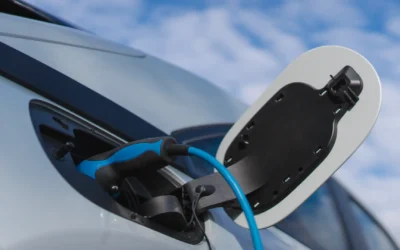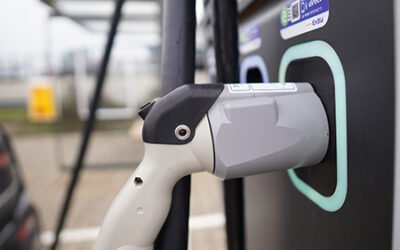• One of the main supporting technologies required to support the wide-scale adoption of electric vehicles is the EV charging infrastructure.
• Charging availability is a critical enabling factor for electric fleet deployment, and the strategic roles of various charging speeds, costs, and locations must be tailored for each fleet application
• Destination charging will increase over the years as logistic hubs and distribution centers install high-capacity chargers, thus reducing the load on depots.
The world has been aware of the potential benefits of E-mobility for some time now. Factors such as its adoption being welcomed by consumers and government subsidies to promote it have all contributed to its rise in popularity over the past decade. Steady progress towards E-mobility and electric vehicles is being made all around the world, and especially in Europe. This includes public transportation, private automobiles, and company fleets. However, in order for the transition to be successful and seamless, the necessary infrastructure for E-mobility, such as rapid chargers, must be established.
In broad terms, it is clear that charging availability is a critical enabling factor for electric fleet deployment, and the strategic roles of various charging speeds, costs, and locations must be tailored for each fleet application. Although very few businesses have chosen to electrify their fleets so far in 2022, this could change as the debate over the gradual elimination of gasoline and diesel fuels continues. This article discusses the infrastructure necessary to support the deployment of E-mobility in various functions.
Charging Infrastructure
Company Cars
The most common method for recharging company cars, which primarily consists of AC charging, is charging at home and in the office. Companies providing their employees with EVs tend to install remote billing enabled EV chargers alongside their residence. This helps companies keep track of vehicle usage and employees can easily be reimbursed for the electricity that is used to charge the company car.
On the other hand, EV drivers who do not have easy access to home charging may benefit greatly from charging at work. The most prevalent type of workplace chargers are AC chargers. Employer-located charging may be particularly useful in promoting EV adoption among drivers whose primary on workplace charging is possible and who do not have access to off-street parking for home charging.
Electric LCVs
Similar to passenger cars, LCVs usually have smaller battery packs and are easily chargeable via AC chargers during overnight charging sessions. The day-to-day work cycle of LCVs usually lasts from morning till evening and the vehicles are parked in the depot at night. This case allows for overnight charging for such vehicles via AC chargers.
However, depending on the distance travelled, there is a possibility that they may need to recharge during work hours, as well. In such instances, case studies suggest that the ideal charging strategy for these vehicles comprise of a combination of AC and DC charging. The vehicles can top-up while loading/unloading at depots or during breaks via DC chargers, as well as charge via AC chargers overnight. Publicly installed EV charging infrastructure is also accessible to these vehicles.
Electric Buses
The charging infrastructure for buses is located at depots and consists of a variety of charging options. Overnight charging via 30-50 kW cable or pantograph chargers in the depot is usually the norm, along with a number of high-powered 150-350 kW chargers installed for quick top-up during work hours. Secondly, as recent case studies have identified, the adoption of higher-powered cabinets or charging systems (150 – 350 kW), with parallel charging features for slow charging overnight and rapid charging during work hours is another possibility. Moreover, top-down pantograph chargers with capacities above 350 kW are usually installed along bus routes to provide a quick charger as buses stop to drop and pick up passengers at bus stops.
Trucks
The number of E-Truck registrations saw an increase in 2021, especially in the new medium and heavy commercial vehicles category, weighing over 3.5 tons. It is possible to attribute the apparent slow uptake of E-Trucks to the challenges that have accompanied the transition. The charging infrastructure necessary for fully electric fleets is currently not in place across Europe; the lack of infrastructure for trucks being the key challenge for the transition. Public charging and reliable infrastructure are vital changes necessary to improve fleet managers’ feelings toward full fleet electrification. For the adoption of E-Trucks to accelerate, there is great need for development in wholly owned charging in addition to public charging options.
To help infrastructure providers and fleet managers anticipate the concrete charging needs, knowing the potential energy consumption of the trucks for a certain distance will prove useful. A lighter truck, driving in cities or making short journeys of less than 150 km, will neither require the same charging infrastructure nor power as a truck driving across Europe. Depot charging, comprising of chargers with power ratings between 22 kW AC to 100 kW DC, will be widely used to charge trucks that drive one shift per day.
When truck drivers are expected to take on several shifts or when the battery is not large enough to cover the daily journey, they need to charge at the location of the customer whilst loading and unloading process. Vehicles are expected to charge with an output between 150-350 kW at these loading stations. The enroute charging strategy heavily relies on public charging infrastructure such as gas stations, rest areas, or charging hubs along the highway. This method of complete reliance on public charging is more suitable for operators with long-haul operations. Here, E-Trucks would require short-time charging solutions with at least 350 kW-1 MW capacities in the future.
Destination charging will increase over the years as logistic hubs and distribution centers install high-capacity chargers, thus reducing the load on depots. This has been illustrated in the figure below. Although depot charging will reduce in favor of public charging and destination charging, the majority of charging will still take place at depots, over the next decade.


Figure 1: Energy Requirement for E-Trucks: 2025 versus 2030.
EV Charging Infrastructure Service Overview
The research presented in this article is from PTR's EV Charging Infrastructure market research. For information about this service please submit a request shown below.
Contact Sales:
Europe
+49-89-12250950
Americas
+1 408-604-0522
Japan
+81-80-7808-1378
GCC/Rest of APAC
+971-58-1602441
More about our:
EV Charging Infrastructure Market Research
Recent Insights
Sustainability Across Sectors: Highlights from GreenTech Festival 2024
Recently, I had the privilege to attend and present at the Greentech Festival, an excellent event in the realm of sustainability. This influential...
An Evolving Market: Rise of Electric Vehicles in Europe (2023)
This infographic examines the electric vehicle (EV) market in the European region. It highlights the current and forecasted EV market size of each...
Evolution of V2G: CPOs-Automotive OEMs-Utilities at the center of transition
Evolution of V2G: CPOs-Automotive OEMs-Utilities at the center of transition [ba_advanced_divider active_element="text" title="About the Whitepaper"...


